A Method for Improving Radio Frequency Rectification Efficiency in Low-Resistance Loads
Abstract
1. Introduction
2. The Structure of the Rectifier Circuit
3. The Proposed DC-DC Converter
4. Experimental Validation and Discussion
5. Conclusions
Author Contributions
Funding
Data Availability Statement
Conflicts of Interest
References
- Hemour, S.; Zhao, Y.; Lorenz, C.H.P.; Houssameddine, D.; Gui, Y.; Hu, C.M.; Wu, K. Towards Low-Power High-Efficiency RF and Microwave Energy Harvesting. IEEE Trans. Microw. Theory Tech. 2014, 62, 965–976. [Google Scholar] [CrossRef]
- Wang, N.X.; Wang, H.W.; Mei, J.; Mohammadi, S.; Moon, J.; Lang, J.H.; Kirtley, J.L. Robust 3-D Wireless Power Transfer System Based on Rotating Fields for Multi-User Charging. IEEE Trans. Energy Convers. 2021, 36, 693–702. [Google Scholar] [CrossRef]
- Kang, H.-B.; Choi, B.-G.; Sung, M.Y.; Chung, J. Dual Field Communication Scheme for UHF (860–960 MHz) Gen2 RFID Chip. Integr. Ferroelectr. 2011, 125, 1–10. [Google Scholar] [CrossRef]
- Xu, P.; Flandre, D.; Bol, D. Analysis and Design of RF Energy-Harvesting Systems with Impedance-Aware Rectifier Sizing. IEEE Trans. Circuits Syst. II Express Briefs 2023, 70, 361–365. [Google Scholar] [CrossRef]
- Rotenberg, S.A.; Podilchak, S.K.; Re, P.D.H.; Mateo-Segura, C.; Goussetis, G.; Lee, J. Efficient Rectifier for Wireless Power Transmission Systems. IEEE Trans. Microw. Theory Tech. 2020, 68, 1921–1932. [Google Scholar] [CrossRef]
- Muhammad, S.; Tiang, J.J.; Wong, S.K.; Iqbal, A.; Smida, A.; Azizi, M.K. A Compact Dual-Port Multi-Band Rectifier Circuit for RF Energy Harvesting. Comput. Mater. Contin. 2021, 68, 167–184. [Google Scholar] [CrossRef]
- Zhao, F.; Inserra, D.; Gao, G.; Huang, Y.; Li, J.; Wen, G. High-Efficiency Microwave Rectifier with Coupled Transmission Line for Low-Power Energy Harvesting and Wireless Power Transmission. IEEE Trans. Microw. Theory Tech. 2021, 69, 916–925. [Google Scholar] [CrossRef]
- Muhammad, S.; Tiang, J.J.; Wong, S.K.; Nebhen, J.; Smida, A.; Waly, M.I.; Iqbal, A. Broadband RCN-based RF-rectifier with a large range of power for harvesting ambient wireless energy. AEU Int. J. Electron. Commun. 2022, 152, 154228. [Google Scholar] [CrossRef]
- Huang, Y.; Shinohara, N.; Mitani, T. A Constant Efficiency of Rectifying Circuit in an Extremely Wide Load Range. IEEE Trans. Microw. Theory Tech. 2014, 62, 986–993. [Google Scholar] [CrossRef]
- Song, G.; Liu, X.; Liu, C. Wide-Range Rectifier for Wireless Power Transfer Based on Power Compensation. IEEE Microw. Wirel. Compon. Lett. 2021, 31, 509–512. [Google Scholar] [CrossRef]
- Zhang, X.Y.; Du, Z.X.; Xue, Q. High-Efficiency Broadband Rectifier with Wide Ranges of Input Power and Output Load Based on Branch-Line Coupler. IEEE Trans. Circuits Syst. I Regul. Pap. 2017, 64, 731–739. [Google Scholar] [CrossRef]
- Liu, C.; Lin, H.; He, Z.; Chen, Z. Compact Patch Rectennas without Impedance Matching Network for Wireless Power Transmission. IEEE Trans. Microw. Theory Tech. 2022, 70, 2882–2890. [Google Scholar] [CrossRef]
- Li, Y.; Yan, Y.; Yang, H.; Hu, J.; He, Z. A Reconfigurable Rectifier-Based Power Improving Method of Free-Standing Two-Coil Magnetic Field Energy Harvesters Over a Wide Load Range. IEEE Trans. Power Electron. 2023, 38, 5638–5643. [Google Scholar] [CrossRef]
- Huang, Y.; Shinohara, N.; Mitani, T. Impedance Matching in Wireless Power Transfer. IEEE Trans. Microw. Theory Tech. 2017, 65, 582–590. [Google Scholar] [CrossRef]
- Fu, M.; Zhang, T.; Zhu, X.; Ma, C. A 13.56 MHz wireless power transfer system without impedance matching networks. In Proceedings of the 2013 IEEE Wireless Power Transfer (WPT), Perugia, Italy, 15–16 May 2013; pp. 222–225. [Google Scholar]
- Moriwaki, Y.; Imura, T.; Hori, Y. Basic study on reduction of reflected power using DC/DC converters in wireless power transfer system via magnetic resonant coupling. In Proceedings of the 2011 IEEE 33rd International Telecommunications Energy Conference (INTELEC), Amsterdam, the Netherlands, 9–13 October 2011; pp. 1–5. [Google Scholar]
- Dolgov, A.; Zane, R.; Popovic, Z. Power Management System for Online Low Power RF Energy Harvesting Optimization. IEEE Trans. Circuits Syst. I Regul. Pap. 2010, 57, 1802–1811. [Google Scholar] [CrossRef]
- Ajami, A.; Ardi, H.; Farakhor, A. A Novel High Step-up DC/DC Converter Based on Integrating Coupled Inductor and Switched-Capacitor Techniques for Renewable Energy Applications. IEEE Trans. Power Electron. 2015, 30, 4255–4263. [Google Scholar] [CrossRef]
- Leal, W.C.; Godinho, M.O.; Bastos, R.F.; Aguiar, C.R.d.; Fuzato, G.H.F.; Machado, R.Q. Cascaded Interleaved DC–DC Converter for a Bidirectional Electric Vehicle Charging Station. IEEE Trans. Ind. Electron. 2024, 71, 3708–3717. [Google Scholar] [CrossRef]
- Bui, V.C.; Nguyen, M.K.; Duong, T.D.; Vo, D.V.; Lim, Y.C.; Choi, J.H. A Novel Isolated DC–DC Converter for High Step-Down Applications. IEEE Access 2023, 11, 81545–81562. [Google Scholar] [CrossRef]
- Yuan, Y.; Peng, N.; Liu, W.; Yi, C. A Linear-Resonant Hybrid Bridge DC–DC Converter. IEEE Trans. Ind. Electron. 2023, 70, 1478–1488. [Google Scholar] [CrossRef]
- He, Z.; Lan, J.; Liu, C. Compact Rectifiers with Ultra-wide Input Power Range Based on Nonlinear Impedance Characteristics of Schottky Diodes. IEEE Trans. Power Electron. 2021, 36, 7407–7411. [Google Scholar] [CrossRef]
- Ho, T.S.; Ramiah, H.; Churchill, K.K.P.; Chen, Y.; Mak, P.I.; Martins, R.P. Extended Power Dynamic Range and Enhanced Power Conversion Efficiency of a Switched-Capacitor DC–DC Converter: A Tutorial. IEEE Trans. Circuits Syst. II Express Briefs 2024, 71, 1606–1612. [Google Scholar] [CrossRef]
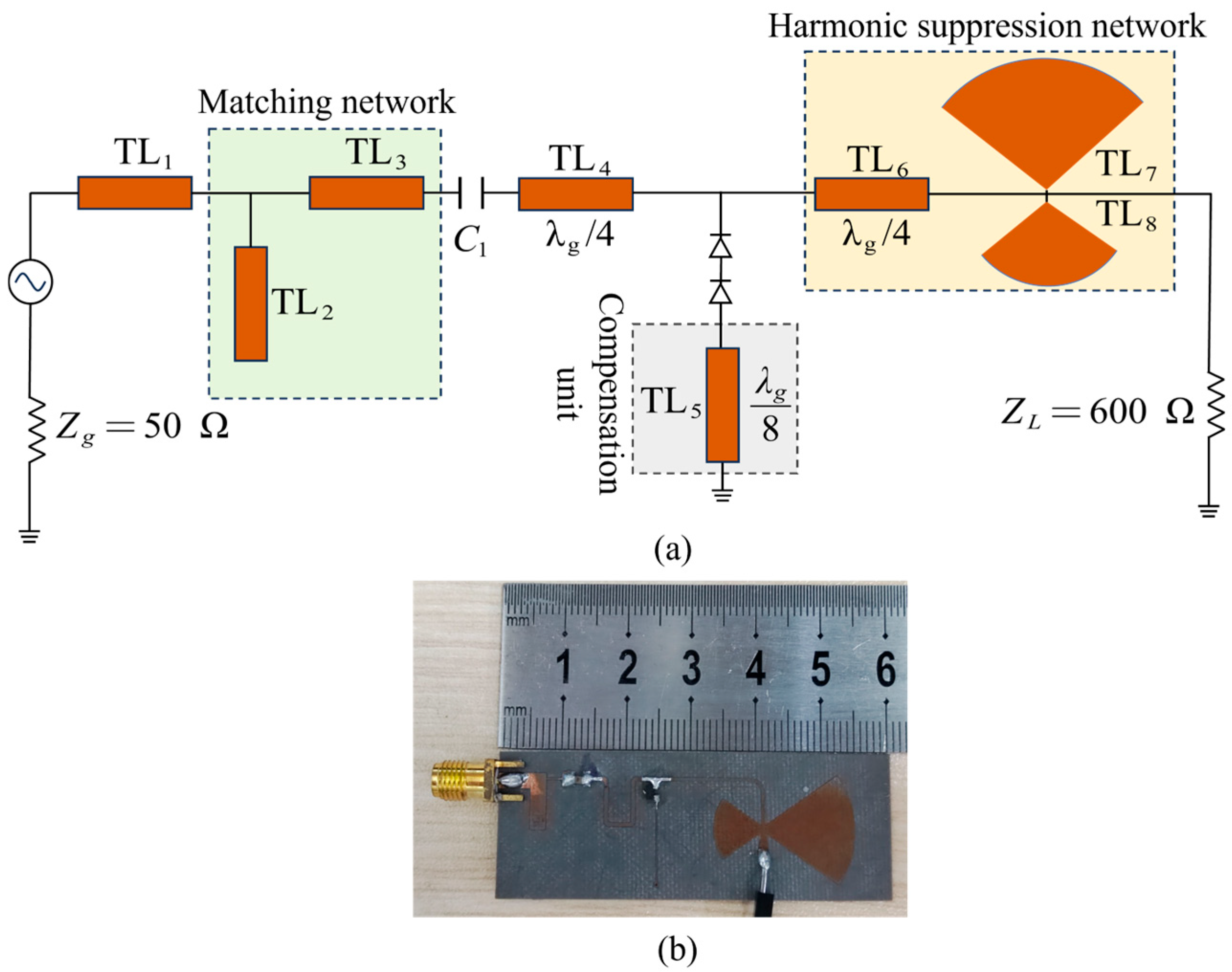


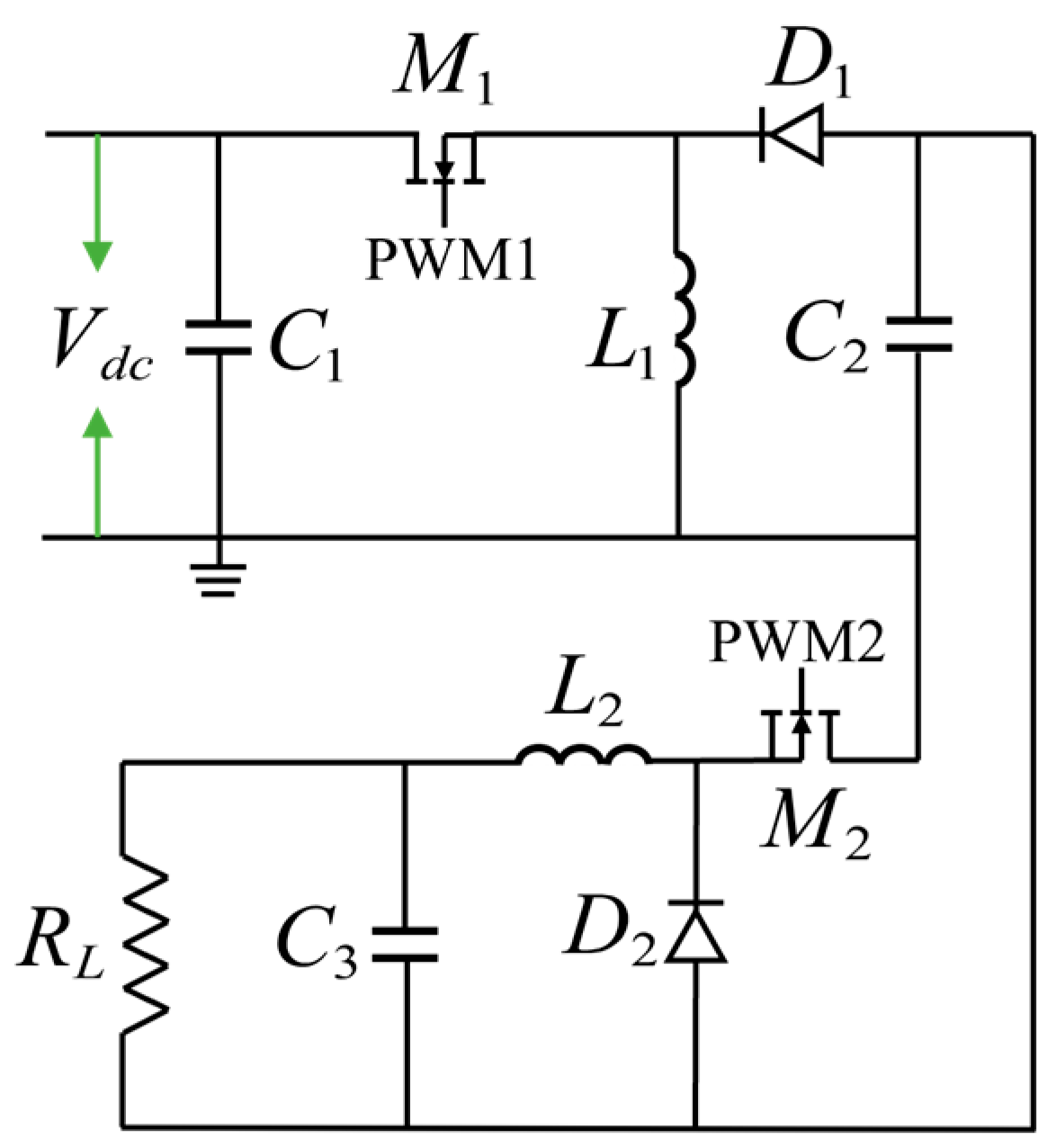



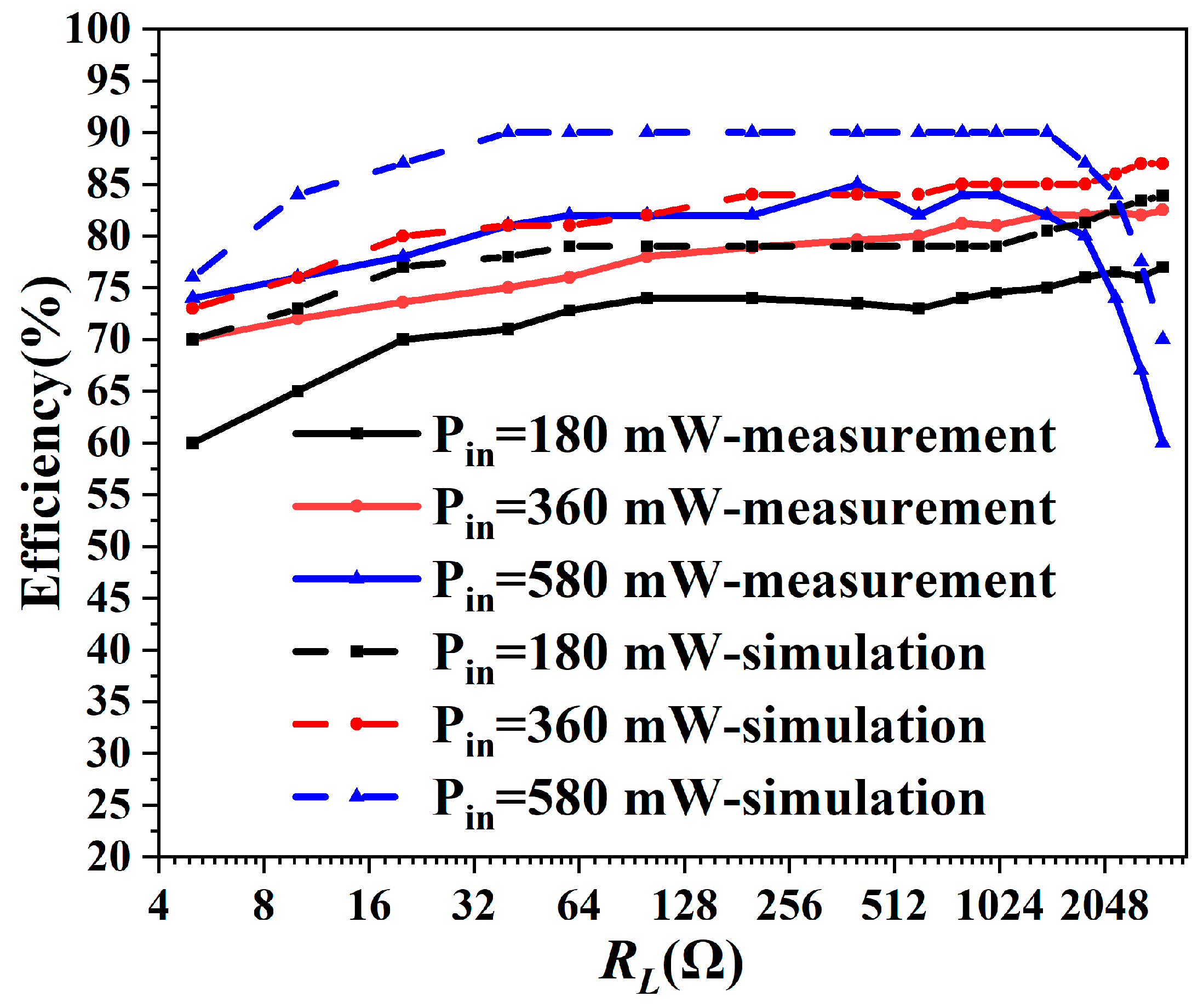
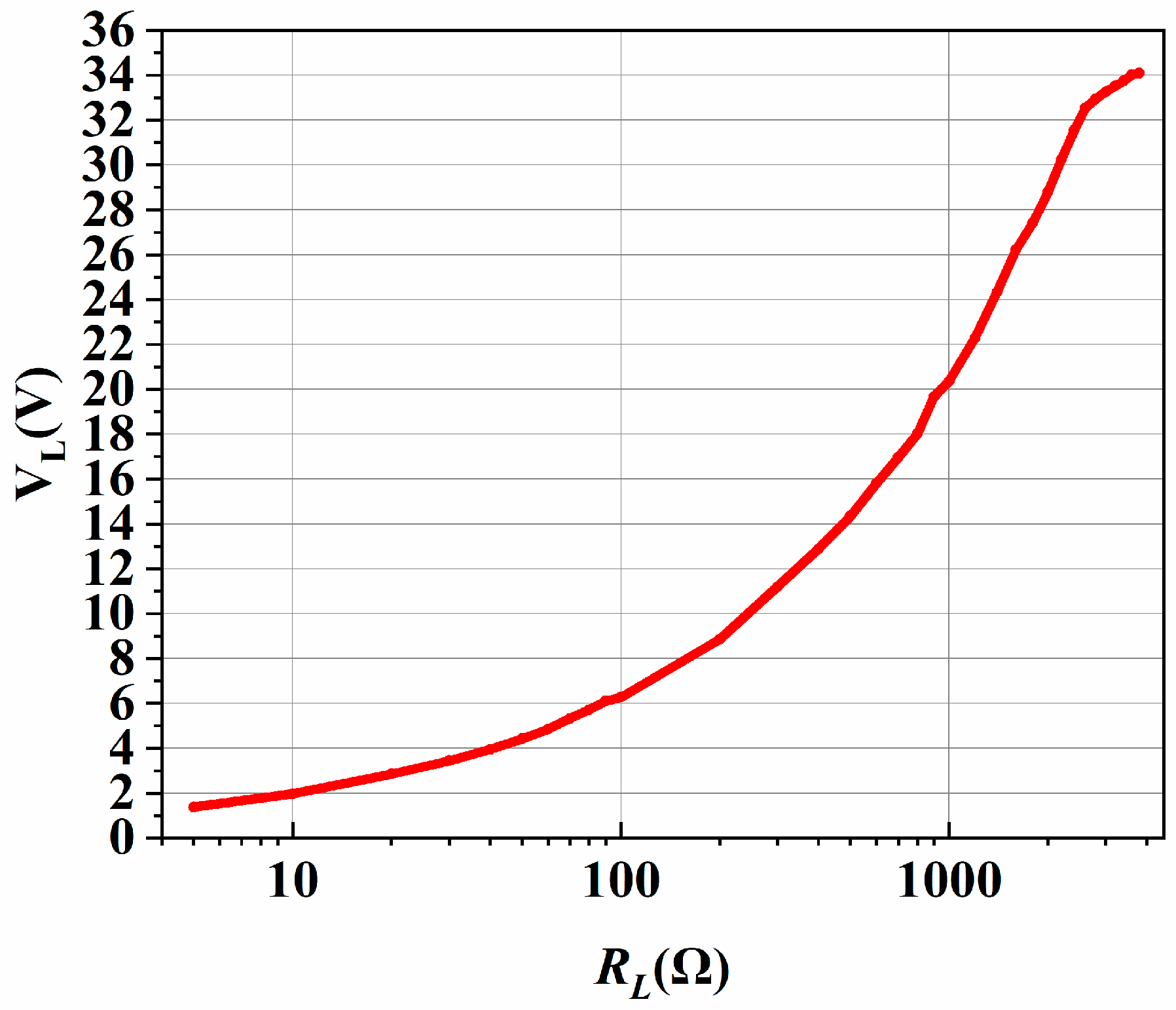
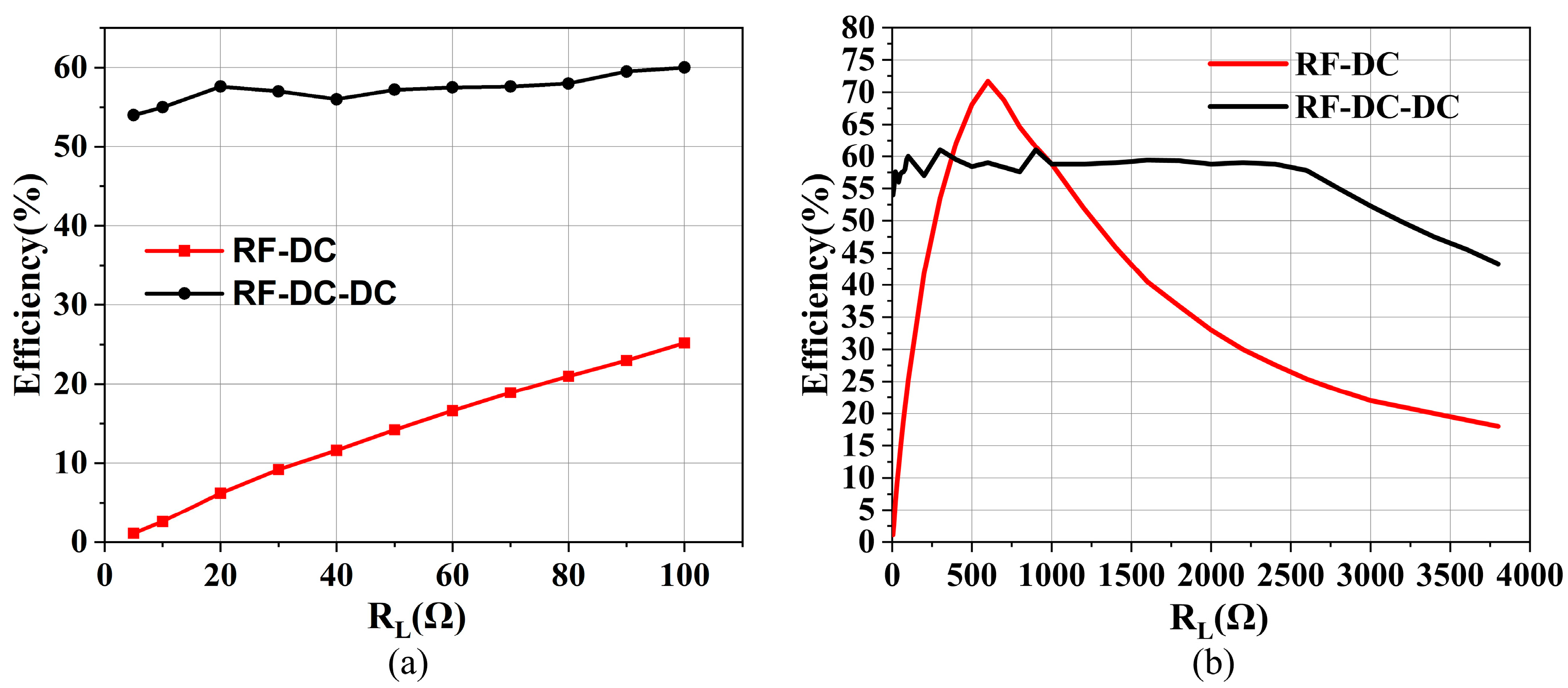
| PWM Signal | Frequency | Duty Cycle |
|---|---|---|
| PWM1 | 53 kHz | 24% |
| PWM2 | 20 kHz | 20% |
| Component | Part No. | Description |
|---|---|---|
| MOSFET M1 and M2 | FDS4559 | VDSS = 60 V; RDS (on) = 75 mΩ (VGS = 4.5 V) |
| Inductance L1 and L2 | 90125-330UH | L = 330 µH; Rdc = 0.05 Ω; Idc = 8 A |
| Schottky diodes D1 and D2 | SS34 | VRRM = 40 V; VFM = 0.55 V |
| Ref. | Freq. (MHz) | DC-DC Converter | Load Range for Overall PCE > 50% | Maximum Conversion Efficiency of the Converter | Applicable Power Range | Year |
|---|---|---|---|---|---|---|
| [17] | 1960 | Boost converter in CRM at low power level, in DCM at higher power level | No discussion | 87% | 50 µW~1000 µW | 2010 |
| [16] | 13.16 | Buck converter in CCM | 4.7 Ω~50 Ω | No discussion | No discussion | 2011 |
| [9] | 2450 | Boost-Buck converter in DCM | 100 Ω~5000 Ω | 86% | 21 mW~102 mW | 2014 |
| [18] | - | Boost converter | - | 96.9% | 20~300 W | 2015 |
| [11] | 2450 | No DC-DC converter | 50 Ω~450 Ω | —— | 2 mW~100 mW | 2016 |
| [14] | 2450 | Boost-Buck converter in DCM | 100 Ω~10,000 Ω | 86% | No discussion | 2019 |
| [10] | 915 | No DC-DC converter | 8 kΩ~97 kΩ | —— | 0.6 mW~32 mW | 2021 |
| [12] | 2450 | No DC-DC converter | 50 Ω~200 Ω | —— | 20 mW~200 mW | 2022 |
| [13] | 5 × 10−5 | No DC-DC converter | 50 Ω~1500 Ω | —— | No discussion | 2023 |
| This work | 2450 | Boost-buck converter in DCM +Buck converter in CCM at low-resistance loads, in DCM at high resistance loads | 5 Ω~3000 Ω | 85% | 180 mW~580 mW | 2024 |
Disclaimer/Publisher’s Note: The statements, opinions and data contained in all publications are solely those of the individual author(s) and contributor(s) and not of MDPI and/or the editor(s). MDPI and/or the editor(s) disclaim responsibility for any injury to people or property resulting from any ideas, methods, instructions or products referred to in the content. |
© 2024 by the authors. Licensee MDPI, Basel, Switzerland. This article is an open access article distributed under the terms and conditions of the Creative Commons Attribution (CC BY) license (https://creativecommons.org/licenses/by/4.0/).
Share and Cite
Jiang, Z.; Liu, R.; Yang, Y.; Zhu, H. A Method for Improving Radio Frequency Rectification Efficiency in Low-Resistance Loads. Electronics 2024, 13, 2496. https://doi.org/10.3390/electronics13132496
Jiang Z, Liu R, Yang Y, Zhu H. A Method for Improving Radio Frequency Rectification Efficiency in Low-Resistance Loads. Electronics. 2024; 13(13):2496. https://doi.org/10.3390/electronics13132496
Chicago/Turabian StyleJiang, Zhongkui, Rufan Liu, Yang Yang, and Huacheng Zhu. 2024. "A Method for Improving Radio Frequency Rectification Efficiency in Low-Resistance Loads" Electronics 13, no. 13: 2496. https://doi.org/10.3390/electronics13132496
APA StyleJiang, Z., Liu, R., Yang, Y., & Zhu, H. (2024). A Method for Improving Radio Frequency Rectification Efficiency in Low-Resistance Loads. Electronics, 13(13), 2496. https://doi.org/10.3390/electronics13132496







